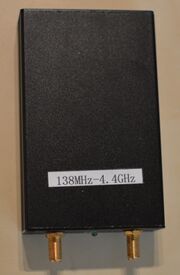BG7TBL
 | |
| Status | planned |
|---|---|
| Frequency (user) | 138MHz-4.4GHz |
| Waveforms | sine (fixed) |
| Amplitude | ? V |
| Connectivity | USB |
The BG7TBL USB RF Signal Generator is a PC-based function generator. It has no external controls, requiring a USB connection to a computer.
Software to run this hardware can be found here http://www.dl4jal.eu/.
This device can be bought on ebay for ca $65. Search for "138MHz-4.4GHz". There is a version with the ADF4351 instead that will give you more range (35MHz-4.4GHz).
Hardware
- Microcontroller: Atmel Atmega 8L
- Wideband Synthesizer: ADF4350
- USB to Serial: FTDI FT232RL
- Logarithmic Amplifier AD8307
- Mixer: IAM 81008
- LDO: AMS1117
Photos
Protocol
Baud 57600, 8n1
The protocol is binary serial based.
Query firmware
- Send 0x8f+"v"
The answer should be in hex:
- 77
Where the returned byte is the firmware version, 0x77 = 119 = 'w'.
#!/usr/bin/python
import serial
ser = serial.Serial('/dev/ttyUSB0', 57600, timeout=1) # Linux first FTDI
ser.write("\x8f" + "v")
print("version is " + ser.read())
Signal generator
Setting frequency
To set a frequency send:
- 0x8f
Then f and then the frequency divided by 10 with leading zeroes. For example this is the payload for 400MHz.
- 400 000 000 / 10
- f040000000
#!/usr/bin/python
import sys, serial
ser = serial.Serial('/dev/ttyUSB0', 57600, timeout=1) # Linux first FTDI
# sys.argv[1] is frequency in Herz
cmd = "\x8f" + "f" + '{:09d}'.format(int(sys.argv[1])/10)
ser.write(cmd)
Spectrum analyzer
The protocol is briefly described in the source code here:
https://github.com/DoYouKnow/BG7TBL_Reader
Here is a minimal code for an 'x' sweep (the protocol is described in chapter 6 of http://www.dl4jal.eu/LinNWT_doc_en.pdf ). The device sends back the expected number of bytes but it seems I have to divide the frequency by 10... (?).
#!/usr/bin/python
import sys, serial, struct
start_frequency = 100000000 # FM band
increment = 20000
steps = 2000
#
# 'x' sweep (writing the command returns (4 * steps) bytes (what is it, I don't know)
#
cmd = "\x8f" + "x" + '{:09d}{:08d}{:04d}'.format(start_frequency/10, increment, steps)
ser = serial.Serial('/dev/ttyUSB0', 57600, timeout=100) # Linux first FTDI
ser.write(cmd)
rsp = ser.read(4 * steps)
if len(rsp) < (4 * steps):
sys.stderr.write("Warning : Did not read enough measures! Try increasing the timeout\n")
steps = len(rsp)/4 # adapt to the number of measures read
val_tab = struct.unpack_from("<" + "h"*2*steps, rsp) # 2 * steps 'little endian shorts'
for i in range(0, steps):
print(val_tab[2*i]) # channel A (A and B are interleaved)

